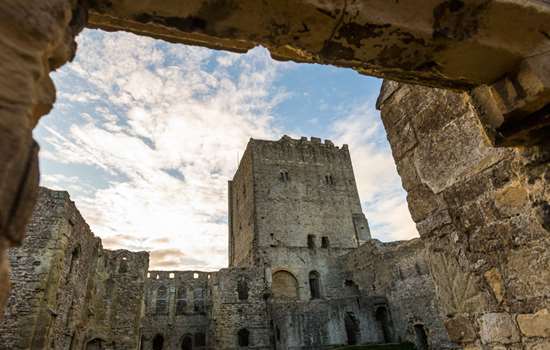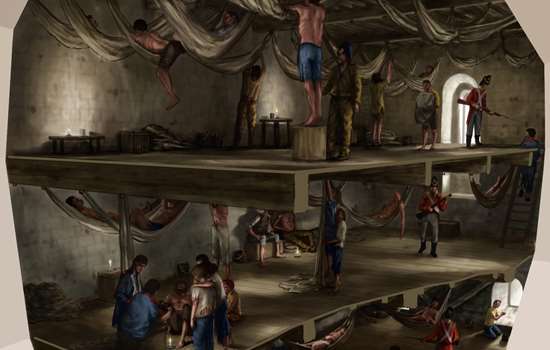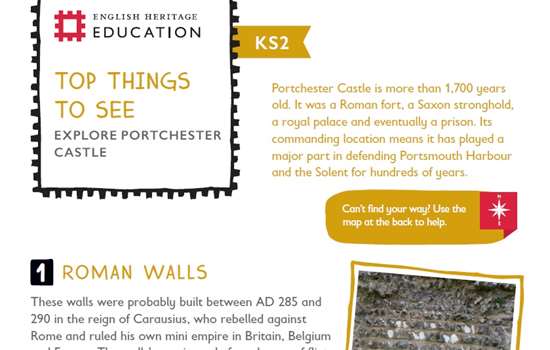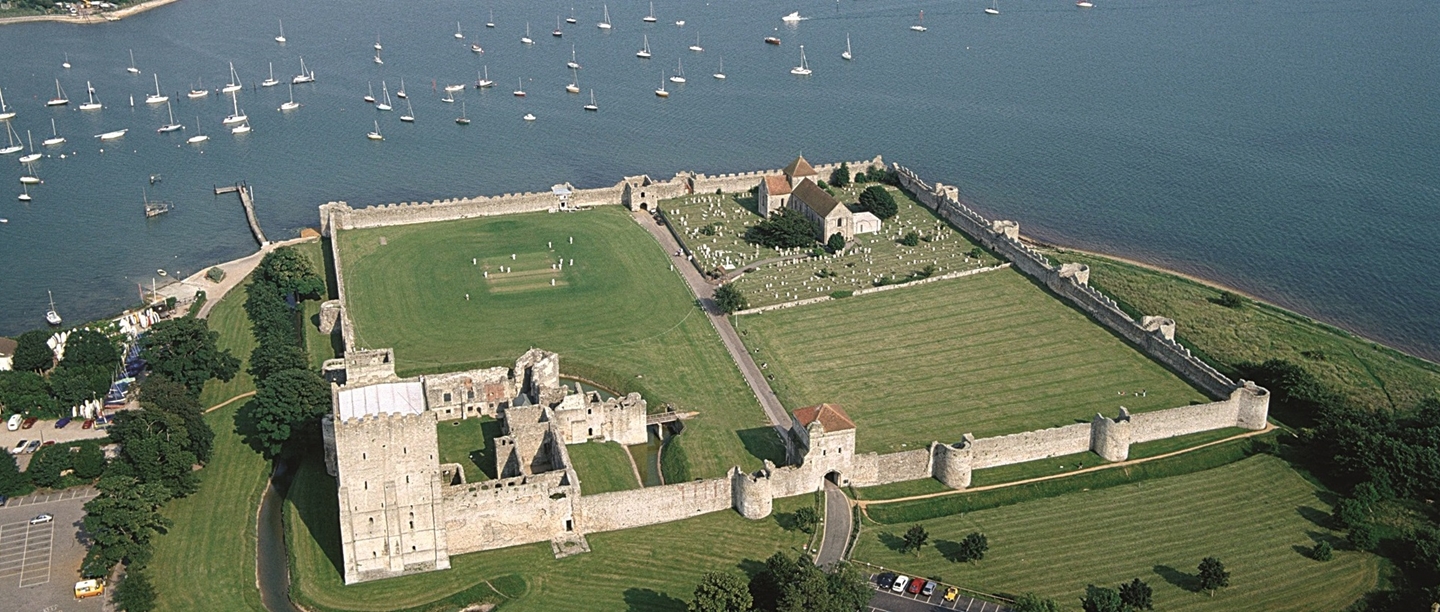Get to grips with the area
The walls and buildings at Portchester are perfect examples of how a place can change over time. Portchester’s location, in a defensive position at the north end of Portsmouth Harbour, has shaped its use over the centuries. Portsmouth Harbour is naturally defended by the Isle of Wight and the bit of land on which Portchester Castle sits.
The Romans built a huge fort here in AD 285–290, to help defend the south coast of England. The site eventually became a Saxon burh in the early 11th century – one of a series of forts that protected the Anglo-Saxon kingdoms from Viking attack.
After the Norman Conquest of 1066, a castle was built in one corner of the fort, which grew into an impressive royal residence, used by a long line of medieval kings, until Charles I (r.1625–49) sold it in 1632.
Portchester Castle was used to hold prisoners of war as early as 1306, making it the oldest regular war prison in Britain. It was a prison during all the major wars of the 18th century. During the French Revolutionary Wars (1792–1802) and the Napoleonic Wars (1803–15), Portchester Castle was one of 12 prisoner-of-war depots in Britain and could hold up to 8,000 prisoners. Prisoners came to Portchester from across the globe.
Top Resources
-

Portchester Castle Teachers' Kit (KS1-KS4+)
Download this kit to access practical information, historical information and hands-on activities to do before, during and after your visit.
-

Performance at Portchester Castle Learning Pack (KS2-KS4)
Get inspiration for creative learning projects by exploring the story of the French prisoners of war who, in the early 1800s, formed a theatrical troupe and staged plays for fellow prisoners and the local community.
-

HISTORY OF PORTCHESTER CASTLE
Read our online articles to gain essential insight into over 1,700 years of history at Portchester Castle.
-

PRISONERS OF WAR AT PORTCHESTER CASTLE
Discover what life was like for 8,000 prisoners-of-war during the French Revolutionary and Napoleonic Wars.
Suggested Activities
-

Local History Explorers (KS1-KS3)
Research the local area and understand how nearby places, plus the people associated with them, relate to England’s story.
-

CASTLE SENSORY: SIGHTS, SOUNDS AND SMELLS (SEND, KS1)
Explore key areas of the castle and identify what they were used for, while developing sensory observation skills.
-

TOP THINGS TO SEE (KS2)
Spot interesting landscape and architectural features as you tour the castle and discuss what we can learn from them.
-

MAKING A MELODRAMA (KS2 –KS4)
Draw inspiration from the theatre produced by French prisoners of war to create a character, costume and script in the style of 19th-century melodrama.
Video Resources
-
A Mini Guide To Medieval Castles
Watch our short animation to find out more about how English castle design developed over time.
-
HISTORY AT HOME LIVE! CASTLES
Join Ben Shires and our expert Jeremy Ashbee to develop your understanding of castles and the people that lived in them.
-
HISTORY AT HOME LIVE! CASTLES (PART 2)
Join Ben Shires and our expert Jeremy Ashbee as they talk further about castles and how they developed over time.
-
A BRIEF HISTORY OF THE NORMANS
Discover the origins of the Normans, the story behind the dispute between Harold Godwinson and William the Conqueror, and how the Norman army took control of England.
Link Your Learning
ENGLISH – Use the historical information and sources in the Portchester Castle Teachers' Kit to find out about what it would be like to be a prisoner-of-war, taken captive far from home, away from the fighting. Combine this research with the experience of visitng the site to write a diary entry from the perspective of a prisoner.
GEOGRAPHY – Examine a map of the area around Portchester and ask your learners to identify some of the geographical features they find. What do they notice about the castle’s location within England and Europe? Encourage learners to consider the historical significance of Portchester’s location.
ART AND DESIGN – Many prisoners of war at Portchester were skilled craftsmen who would sell their wares, such as intricate gaming pieces carved from animal bone, to the general public. Design your own set of cards or a chess set, drawing inspiration from the objects made and sold by prisoners at Portchester. You can see these on display at the site, or find pictures of them in the Teachers' Kit.
DRAMA – Download the ‘Performance at Portchester Learning Pack’ to discover drama learning opportunities, such as analysing a script written and staged by the French prisoners, making a melodrama from scratch, and devising contemporary theatre.
Visiting Portchester Castle
'There is nothing like first-hand experience to bring teaching to life. Education visits ensure lasting memories are made and open up learning in a way that can enrich and enhance pupils' understanding, giving them an experience that truly takes them back in time.
Portchester Castle has so many wonderful stories to tell from its time as a Roman fortress to becoming an impressive royal residence and then a prison with a unique theatre, hosting plays to rival the best Parisian performances. Portchester Castle provides ample opportunity for exploring key periods of history and is a fascinating focus for local study.
Entry to Portchester Castle is free for your class and we also offer a free planning visit, as well as a variety of downloadable resources to help with your students’ learning before, during and after your trip. You can also delve deeper into the history of the castle with our expert-led Discovery Visits, which bring the history of the castle to life. I’m here to help, so please do get in touch if I can help with your visit to this very special Castle.'
- Gemma Wiggs, Education Visits Officer (Hampshire & Isle of Wight)
Find Out More



